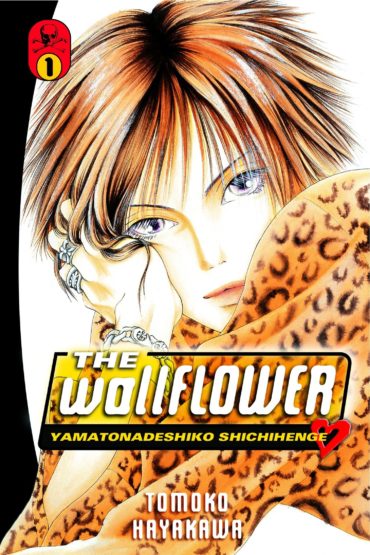The Wallflower Volume 1 Review
The Wallflower (2000-2015) begins with four handsome 15-year-old boys being offered the chance to live rent-free in a massive house. The boys in question are Kyohei (the cool, flamboyant one), Takenaga (the smart one), Yukinojo (the androgynous, normal one) and Ranmaru (the ladies man). The one condition is that the owner has asked them to transform her niece, who also lives in the house, into a perfect lady.
The niece in question, Sunako Nakahara, is a big challenge to transform. Ever since she got rejected by one boy who said he didn’t like “ugly girls”, Sunako has shunned all forms of beauty. She lives constantly in the dark, her hair has grown over her eyes, she loves horror films, her best friends are a dummy skeleton and some anatomical figures, and she gets massive nosebleeds whenever she see someone attractive.
Sunako immediately hates the quartet of boys for they are “creatures of the light”, but they try their hardest to slowly transform her into someone who is relatively normal. For example, they manage to get her to go to school, which at first she likes because she can be alone, but when everyone becomes fascinated with her to the point where the school newspaper starts running a competition to get photos of her, the boys end up having to protect her. However, often it ends up the other way around, with Sunako protecting the boys: all those years of watching horror films mean that she has acquired some good fighting skills so she can protect them when they are harassed by other girls, or people with even dodgier persuasions.
These scenes do add to the comedy of the book, and there are several humorous moments throughout The Wallflower. Plus, Tomoko Hayakawa’s art does add to it, especially at the beginning where we see through Sunako’s eyes, which means having to view the handsome boys through her bangs of her long hair. Sunako’s fighting skills also help when it comes to the comedy, and other more dramatic moments too. There is one scene in which she fights off some men at a party who are inappropriately touching other women which works well. There also appears to be nothing really troublesome with David Ury’s translation and there are lots of notes to help the reader.
However, there are times when the humour feels very off, or at least dated. In one chapter, Kyohei is constantly pestered by the manager of a dodgy host club. It eventually reaches the point where Kyohei ends up being kidnapped. The rest of the gang thus go to rescue him. This begins alright, with the rest of the boys having to infiltrate the club in drag, which they do convincingly. Things start to change however, when we see Kyohei blindfolded, gagged and tied up in chains as the owner of the club puts him up in an auction. Essentially we witness a 15-year-old boy in a bondage scenario for a slave auction. If you think this is problematic, things get worse during the rescue attempt itself, when Sunako whips off her outer clothes to reveal that under this she is wearing a Nazi uniform, complete with an SS “are we the baddies?” peak cap with a skull on it. Yeah, that definitely spells trouble in terms of taste. It is certainly something that you probably would not do today – or at least you hope so.
You could also argue that the plot itself is problematic though, especially these days. The idea that the entire story is forcing a young girl to change the way they live, Eliza Doolittle-style, rather than let her just be herself might be seen as troublesome (coincidentally, in Singapore the series was released under the title My Fair Lady). This is perhaps best indicated in a brief moment when Sunako is arguing with Yukinojo who’s cutting Sunako’s bangs, during which she shouts: “No means no!”, but then Kyohei does it anyway.
When you compare The Wallflower to other similar series such as Ouran High School Host Club, which debuted two years later and brilliantly parodied the harem genre, you can see how things have changed. Ouran is for me one of the best comedy manga series made. The Wallflower was admittedly a big deal in its day, with anime and live-action adaptations, and the manga having run longer than Ouran, but it just doesn’t feel as good, and the series these days seems forgotten. While this edition does come with some nice extras like useful translator notes and an (untranslated) preview of the second volume, I doubt this is a manga I will be returning to.


